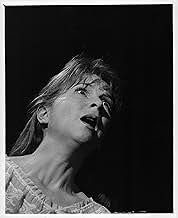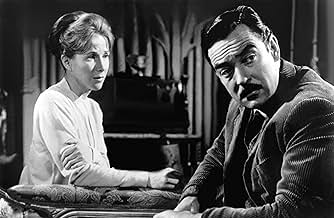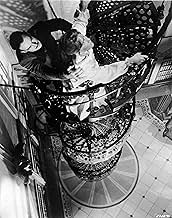Julie Harris(1925-2013)
- Actress
- Soundtrack
One of the finest classical and contemporary leading ladies ever to grace the 20th century American stage, five-time Tony Award winner Julie Harris was rather remote and reserved on camera, finding her true glow in front of the theatre lights. The freckled, red-haired actress not only was nominated for a whopping total of ten Tony awards and was a Sarah Siddons Award recipient for her work on the Chicago stage, she also earned awards in other areas of the entertainment industry, including three Emmys (of 11 nominations), a Grammy and an Academy Award nomination. (Note: Harris would hold the record for the most competitive Tony performance wins (five) for a couple of decades. Angela Lansbury finally caught up with her in 2009 and singer/actress Audra McDonald surpassed them both in 2014 with six). While Harris certainly lacked the buoyancy and glamor usually associated with being a movie star, she certainly made an impact in the early to mid 1950s with three iconic leading roles, two of which she resurrected from the Broadway stage. After that she pretty much deserted film.
Born Julie Ann Harris on December 2, 1925, in Grosse Pointe, Michigan, she was the daughter of William Pickett, an investment banker, and Elsie L. (née Smith) Harris, a nurse. Graduating from Grosse Pointe Country Day School, an early interest in the performance arts was encouraged by her family. Moving to New York City, Julie attended The Hewitt School and later trained as a teenager at the Perry-Mansfield Performing Arts School & Camp in Colorado. A mentor there, Charlotte Perry, saw great hope for young Julie and was insistent that her protégé study at the Yale School of Drama. Julie did just that -- for about a year.
Also trained at the New York School of Drama and one of the earliest members of the Acting Studio, young Julie made her Broadway debut in 1945 at age 19 in the comedy "It's a Gift". Despite its lukewarm reception, the demure, diminutive (5'3"), and delicate-looking thespian moved on. She apprenticed on Broadway for the next few years with ensemble parts in "King Henry IV, Part II" (1946), "Oedipus Rex" (1946), "The Playboy of the Western World" (1946), "Alice in Wonderland" (as the White Rabbit) (1947), and Macbeth" (1948).
More prominent roles came her way in such short-lived Broadway plays as "Sundown Beach" (1948), "The Young and Fair" (1948), "Magnolia Alley" (1949) and "Montserrat (1949). This led to her star-making theatre role at age 24 as sensitive 12-year-old tomboy Frankie Addams in the classic drama "The Member of the Wedding" (1950) opposite veteran actress Ethel Waters and based on the Carson McCullers novel. The play ran for over a year. The Member of the Wedding (1952) would eventually be transferred to film and, despite being untried talents on film, director Fred Zinnemann wisely included both Harris and young Brandon De Wilde (as young John Henry) to reenact their stage triumphs along with Ms. Waters. Harris, at 27, received her first and only Academy Award nomination as the coming-of-age Georgian tomboy.
It wasn't long before Julie's exceptional range and power won noticed nationwide. In 1952, she received her first "Best Actress" Tony Award for creating the larger-than-life role of Sally Bowles in "I Am a Camera," the stage version of one of Christopher Isherwood's Berlin stories ("Goodbye to Berlin" (1939). (Note: In the 1960s, Isherwood's play would be transformed successfully into the Broadway musical "Cabaret".) Harris again was invited to repeat her stage role in I Am a Camera (1955) with Laurence Harvey and Shelley Winters, winning the BAFTA "Best Foreign Actress" Award. That same year Harris starred opposite the highly emotive James Dean (she had top billing) as his love interest in the classic film East of Eden (1955), directed by Elia Kazan from the John Steinbeck novel. Strangely, Julie's brilliance in the role of Abra was completely overlooked come Oscar time...a terrible miscarriage of justice in this author's view.
After this vivid film exposure, Julie's love for the theatre completely dominated her career focus. She continued to increase her Broadway prestige with such plays as "Mademoiselle Colombe" (title role) (1954), "The Lark" (Tony Award: as Joan of Arc) (1955), "The Country Wife" (1957), "The Warm Peninsula" (1959), "Little Moon Over Alban" (1960) (which she took to Emmy-winning TV), "A Shot in the Dark" (1961), "Ready When Your Are, C.B.!" (1964), "Skyscraper" (1965), "Forty Carats" (Tony Award) (1968), "And Miss Reardon Drinks a Little" ) (1971), "The Au Pair Man" (1973) and "In Praise of Love" (1974). In between she gave stellar performances on TV with her Joan of Arc in The Lark (1957); title role in Johnny Belinda (1958); Nora in Ibsen's A Doll's House (1959); Catherine Sloper in The Heiress (1961); title role in Victoria Regina (1961) (for which received an Emmy award); Eliza Doolittle in Pygmalion (1963), and title role in Anastasia (1967).Be
In later years Harris reaped praises and honors for her awe-inspiring one-woman touring shows based on the lives of certain distaff historical figureheads. Her magnificently tormented, Tony-winning "First Lady" Mary Lincoln in "The Last of Mrs. Lincoln" (1972) was the first to be seen on stage and TV, followed by another Tony (and Grammy) Award-winning performance as poetess Emily Dickinson in "The Belle of Amherst" (1976) (directed by close friend Charles Nelson Reilly, as well as her early 1980s solo portrait of author Charlotte Brontë in "Bronte," which started out as a radio play. Julie was now placed among the theatre's luminous "ruling class" alongside legendary veterans Helen Hayes, Katharine Cornell and Judith Anderson.
As time wore on, Harris would become equally respected on film and TV for her portrayals of over-the-edge neurotics, wallflowers and eccentric maiden aunt types as witnessed by her co-starring roles in the films The Haunting (1963), Hamlet (1964) (as Ophelia), Harper (1966), You're a Big Boy Now (1966), Reflections in a Golden Eye (1967), The Bell Jar (1979), and the TV-movies How Awful About Allan (1970) and Home for the Holidays (1972). Perhaps a step down performance wise, the veteran actress, after a period of ill health, became a household name with her regular series work as Lilimae on the TV soap Knots Landing (1979).
At age 60, Harris continued to impress on Broadway with her 1990's versions of Amanda Wingfield in "The Glass Menagerie" and Fonsia Dorsey in "The Gin Game" for which she received her tenth and final Tony nomination. She also toured successfully with a production of "Lettice and Lovage". Unlike many other actors whose film roles disintegrated with appearances in bottom-of-the-barrel lowbudgets, Julie's final two supporting films roles were in two nicely constructed period romantic comedies -- The Golden Boys (2008) and The Lightkeepers (2009).
Ill health dogged Julie's later years (she battled breast cancer in 1981 and suffered two strokes -- one in 2001 (while performing in the Chicago play "Fossils") and again in 2010). Nevertheless, she continued to work almost until the end, including narrating five historical documentaries and giving Emmy-winning voice to such women suffragettes as Susan B. Anthony and Elizabeth Cady Stanton.
Married and divorced three times, Julie had one son by her second marriage -- Peter, who became a theatre critic. She also spent time enjoying the benefits of receiving special awards and honors for her full body of work. Among these, she was inducted into the American Theatre Hall of Fame in 1979, was awarded the National Medal of Arts in 1994, received a "Special Lifetime Achievement" Tony Award in 2002 and was a 2005 Kennedy Center honoree.
Harris died on August 24, 2013, of congestive heart failure at her home in West Chatham, Massachusetts. She was 87.
Born Julie Ann Harris on December 2, 1925, in Grosse Pointe, Michigan, she was the daughter of William Pickett, an investment banker, and Elsie L. (née Smith) Harris, a nurse. Graduating from Grosse Pointe Country Day School, an early interest in the performance arts was encouraged by her family. Moving to New York City, Julie attended The Hewitt School and later trained as a teenager at the Perry-Mansfield Performing Arts School & Camp in Colorado. A mentor there, Charlotte Perry, saw great hope for young Julie and was insistent that her protégé study at the Yale School of Drama. Julie did just that -- for about a year.
Also trained at the New York School of Drama and one of the earliest members of the Acting Studio, young Julie made her Broadway debut in 1945 at age 19 in the comedy "It's a Gift". Despite its lukewarm reception, the demure, diminutive (5'3"), and delicate-looking thespian moved on. She apprenticed on Broadway for the next few years with ensemble parts in "King Henry IV, Part II" (1946), "Oedipus Rex" (1946), "The Playboy of the Western World" (1946), "Alice in Wonderland" (as the White Rabbit) (1947), and Macbeth" (1948).
More prominent roles came her way in such short-lived Broadway plays as "Sundown Beach" (1948), "The Young and Fair" (1948), "Magnolia Alley" (1949) and "Montserrat (1949). This led to her star-making theatre role at age 24 as sensitive 12-year-old tomboy Frankie Addams in the classic drama "The Member of the Wedding" (1950) opposite veteran actress Ethel Waters and based on the Carson McCullers novel. The play ran for over a year. The Member of the Wedding (1952) would eventually be transferred to film and, despite being untried talents on film, director Fred Zinnemann wisely included both Harris and young Brandon De Wilde (as young John Henry) to reenact their stage triumphs along with Ms. Waters. Harris, at 27, received her first and only Academy Award nomination as the coming-of-age Georgian tomboy.
It wasn't long before Julie's exceptional range and power won noticed nationwide. In 1952, she received her first "Best Actress" Tony Award for creating the larger-than-life role of Sally Bowles in "I Am a Camera," the stage version of one of Christopher Isherwood's Berlin stories ("Goodbye to Berlin" (1939). (Note: In the 1960s, Isherwood's play would be transformed successfully into the Broadway musical "Cabaret".) Harris again was invited to repeat her stage role in I Am a Camera (1955) with Laurence Harvey and Shelley Winters, winning the BAFTA "Best Foreign Actress" Award. That same year Harris starred opposite the highly emotive James Dean (she had top billing) as his love interest in the classic film East of Eden (1955), directed by Elia Kazan from the John Steinbeck novel. Strangely, Julie's brilliance in the role of Abra was completely overlooked come Oscar time...a terrible miscarriage of justice in this author's view.
After this vivid film exposure, Julie's love for the theatre completely dominated her career focus. She continued to increase her Broadway prestige with such plays as "Mademoiselle Colombe" (title role) (1954), "The Lark" (Tony Award: as Joan of Arc) (1955), "The Country Wife" (1957), "The Warm Peninsula" (1959), "Little Moon Over Alban" (1960) (which she took to Emmy-winning TV), "A Shot in the Dark" (1961), "Ready When Your Are, C.B.!" (1964), "Skyscraper" (1965), "Forty Carats" (Tony Award) (1968), "And Miss Reardon Drinks a Little" ) (1971), "The Au Pair Man" (1973) and "In Praise of Love" (1974). In between she gave stellar performances on TV with her Joan of Arc in The Lark (1957); title role in Johnny Belinda (1958); Nora in Ibsen's A Doll's House (1959); Catherine Sloper in The Heiress (1961); title role in Victoria Regina (1961) (for which received an Emmy award); Eliza Doolittle in Pygmalion (1963), and title role in Anastasia (1967).Be
In later years Harris reaped praises and honors for her awe-inspiring one-woman touring shows based on the lives of certain distaff historical figureheads. Her magnificently tormented, Tony-winning "First Lady" Mary Lincoln in "The Last of Mrs. Lincoln" (1972) was the first to be seen on stage and TV, followed by another Tony (and Grammy) Award-winning performance as poetess Emily Dickinson in "The Belle of Amherst" (1976) (directed by close friend Charles Nelson Reilly, as well as her early 1980s solo portrait of author Charlotte Brontë in "Bronte," which started out as a radio play. Julie was now placed among the theatre's luminous "ruling class" alongside legendary veterans Helen Hayes, Katharine Cornell and Judith Anderson.
As time wore on, Harris would become equally respected on film and TV for her portrayals of over-the-edge neurotics, wallflowers and eccentric maiden aunt types as witnessed by her co-starring roles in the films The Haunting (1963), Hamlet (1964) (as Ophelia), Harper (1966), You're a Big Boy Now (1966), Reflections in a Golden Eye (1967), The Bell Jar (1979), and the TV-movies How Awful About Allan (1970) and Home for the Holidays (1972). Perhaps a step down performance wise, the veteran actress, after a period of ill health, became a household name with her regular series work as Lilimae on the TV soap Knots Landing (1979).
At age 60, Harris continued to impress on Broadway with her 1990's versions of Amanda Wingfield in "The Glass Menagerie" and Fonsia Dorsey in "The Gin Game" for which she received her tenth and final Tony nomination. She also toured successfully with a production of "Lettice and Lovage". Unlike many other actors whose film roles disintegrated with appearances in bottom-of-the-barrel lowbudgets, Julie's final two supporting films roles were in two nicely constructed period romantic comedies -- The Golden Boys (2008) and The Lightkeepers (2009).
Ill health dogged Julie's later years (she battled breast cancer in 1981 and suffered two strokes -- one in 2001 (while performing in the Chicago play "Fossils") and again in 2010). Nevertheless, she continued to work almost until the end, including narrating five historical documentaries and giving Emmy-winning voice to such women suffragettes as Susan B. Anthony and Elizabeth Cady Stanton.
Married and divorced three times, Julie had one son by her second marriage -- Peter, who became a theatre critic. She also spent time enjoying the benefits of receiving special awards and honors for her full body of work. Among these, she was inducted into the American Theatre Hall of Fame in 1979, was awarded the National Medal of Arts in 1994, received a "Special Lifetime Achievement" Tony Award in 2002 and was a 2005 Kennedy Center honoree.
Harris died on August 24, 2013, of congestive heart failure at her home in West Chatham, Massachusetts. She was 87.









































